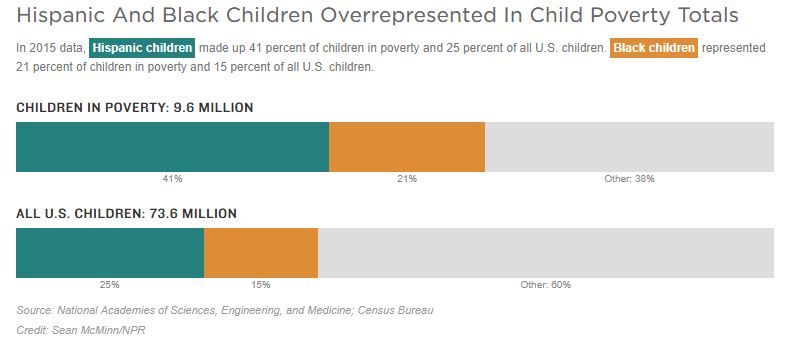News

Report: Child Poverty Could Be Cut In Half Over 10 Years, At A Hefty Price
By: Pam Fessler | NPR
Posted on:
Child poverty in the U.S. could be cut in half over the next 10 years with a few simple steps, according to a new report from the National Academies of Sciences, Engineering and Medicine.
The cost would be high — at least $90 billion a year. But the National Academies report warns that the price of not doing anything would be far greater.
The group estimates that current levels of child poverty cost the U.S. between $800 billion and $1.1 trillion a year, due to lower productivity when poor children become adults and increased costs due to higher crime and poor health. Individual children also suffer, because they face lower educational achievement, maltreatment and other obstacles related to growing up poor. In the end, the panel says, the whole country pays the price.
“Capable, responsible, and healthy adults are the foundation of any well-functioning and prosperous society, yet in this regard the future of the United States is not as secure as it could be,” says the report, which was released after a two-year study commissioned by Congress. It was conducted by a nonpartisan panel of poverty experts, primarily academics.
To fix the problem, the panel suggests two possible packages. The first would expand existing programs that encourage work but also provide direct assistance. This would include increasing the earned income tax credit and child and dependent care tax credits for working families, and expanding housing vouchers and the Supplemental Nutritional Assistance Program, also known as food stamps.
The panel says that these changes would cost about $90.7 billion a year but would bring about 400,000 people into the workforce and cut the childhood poverty rate in half within 10 years.
The second suggestion is to expand the earned income and child care tax credits, raise the minimum wage and eliminate restrictions on immigrant families’ access to government aid. The package also would provide a $2,700 yearly allowance for each child. This package would cost $109 billion a year but create some 600,000 jobs, while also cutting the child poverty rate in half.
The panel estimates that in 2015, 9.6 million children — or 13 percent — lived in poverty. Two million of those children were in “deep poverty,” which means their families had resources that fell below half the poverty line. In 2015, that line was $26,000 for a family of four.
The poverty rate for children in immigrant families was twice as high as for those living in nonimmigrant families — 21 percent compared with 10 percent. Poverty among black and Hispanic children also was more than twice as high as for non-Hispanic white children, according to the National Academies calculations.
The big question is whether Congress will accept the panel’s suggestions. The trend in recent years has been to cut or limit government assistance for the poor, and the Trump administration has indicated that its next budget will call for steep cuts in domestic spending.
The panel also found that some conservative initiatives intended to reduce child poverty — such as programs to promote marriage and family planning — showed little evidence of working. It also found that programs requiring aid recipients to work did not seem to reduce child poverty either. In fact, the report concludes, “It appears that work requirements are at least as likely to increase as to decrease poverty.”
The Trump administration and congressional Republicans have pushed for mandatory work requirements in a number of aid programs, including Medicaid, SNAP and housing assistance.
Marla Dean, executive director of Bright Beginnings, a program in Washington designed to help homeless children and families achieve self-sufficiency, testified before the panel. She says, at the very least, the report could help shape the future debate over how to reduce child poverty by providing rigorous academic research on what does and doesn’t work. But she’s also realistic about the prospects of achieving a lot when the country is so divided politically.
“It is an opportunity [for] hope,” she says, “and that’s what I think this report offers is hope.”
9(MDI4ODU1ODA1MDE0ODA3MTMyMDY2MTJiNQ000))


